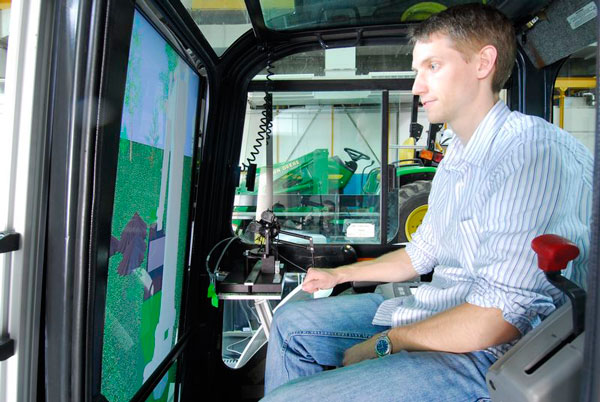Overview
Georgia Tech is one of five core universities in the Center for Compact and Efficient Fluid Power (CCEFP). This website serves as a portal to center projects and the associated faculty, students, and laboratories located at Georgia Tech.About the Center
The CCEFP is a network of researchers, educators, students and industry working together to transform the fluid power industry--how it is researched, applied, and studied. The CCEFP's education and outreach program is designed to transfer this knowledge to diverse audiences--students of all ages, users of fluid power, and the general public.The CCEFP is a National Science Foundation Engineering Research Center, established in June 2006. In addition to its grant from NSF, the Center is supported by its seven participating universities and 55 industrial partners.
Fluid Power Research
Transforming and fully exploiting fluid power into a compact, efficient and effective source of energy transmission-this is the vision of the Engineering Research Center for Compact and Efficient Fluid Power (CCEFP). The Center's work in achieving this vision is and will continue to make transformational societal impacts, reducing polluting petroleum usage and increasing the ways in which fluid power-through human-scale applications-will improve the quality of life, spawning entirely new industries in the process.While the CCEFP strategy has evolved and matured, the vision has remained constant. The needs that inspired it and the accuracy of the course in pursuing it are affirmed by the international fluid power research community and by industry.
As it completes its third year, the CCEFP is already transforming fluid power. The Center has become a catalyst in energizing the fluid power industry and the technology's research community. For the first time in decades, the fluid power industry in the U.S. is thinking seriously about university-industry collaboration on research. U.S. universities are emerging as international leaders in that research, as evidenced by best paper awards presented to Center researchers and their students at recent prominent international conferences. CCEFP connections are leading to a serious discussion of a proposed national fluid power energy policy involving industry, universities and national labs. And, as a direct consequence of CCEFP activities, the fluid power industry is now developing a research-technology roadmap.
The transformational seeds are sown. Societal impact is beginning.
Center Goals
The CCEFP has four goals. The first goal is to dramatically improve the energy efficiency of fluid power in current applications; the second goal is to improve the efficiency of the transportation sector using fluid power by developing fuel efficient hydraulic hybrid technologies suitable for small passenger vehicles; the third goal is to develop un-tethered portable human-scale fluid power devices; and the fourth goal is to make fluid power more acceptable and ubiquitous.Goal 1 - Increase Efficiency in Existing Fluid Power Applications
Fluid power in the agriculture, mining and construction sector consumes $56 billion in energy annually, and fluid power in the machine drives sector of manufacturing consumes $42 billion annually. A ten percent improvement in the energy efficiency of these sectors would save $9.8 billion annually. Such an annual savings is a realistic expectation as an outcome of CCEFP research that is inteGoal 2 - Expand Fluid Power Use in the Transportation Sector to Reduce Fuel Consumption The transportation sector consumes $480 billion in energy annually of which $200 billion is consumed by passenger cars. Hydraulic hybrid vehicles are just coming on the market. Prototype or near market vehicles include refuse trucks, city busses, SUVs and delivery vans. Energy savings in these sectors are expected to be a few hundred million dollars a year for each sector. A ten percent improvement in the energy efficiency of passenger vehicles would save $20 billion annually, a much larger amount. Although current hydraulic hybrid technology can be used for heavier vehicles, it is too large and heavy for competitive use in passenger vehicles. The realization of the goal of the hydraulic hybrid passenger vehicle requires new compact approaches that will be developed by the CCEFP.Goal 3 - Create Portable, Untehthered Human-Scale Fluid Power Applications
Personal service robots are just one example of un-tethered portable human-scale fluid power devices. The market for service robots is estimated to be worth $10 billion in a decade (Japan Government Report, March 2005). These robots must be energetically autonomous to be truly effective, but there currently exists no power supply or actuation system capable of powering a human-scale robot for extended periods of time. Because electric motors and batteries are heavy, this approach cannot provide the required energy, and typical running times for these systems are limited to about twenty minutes. Because of the intrinsic power density advantage of fluid power, it is the natural technology for human-scale, un-tethered applications.The CCEFP will develop novel fluid power based compact power and actuation systems that will provide an order of magnitude greater energy and power density than state-of-the-art batteries and motor drives, thus overcoming one of the major barriers to the development of portable human-scale fluid power devices.
Goal 4 - Make Fluid Power Safe, Quiet, Clean and Simple-to-Use
Fluid power has been plagued by a number of troublesome factors that have prevented its wider acceptance. No one will use fluid power unless it is clean, quiet, safe and easy to use. It is critical to overcome the barriers of poor human interface, noise and leakage. The goal is to have operator control that is fast, precise and intuitive, to have equipment that is quiet enough to not be obtrusive to the operator, and to have leaks be so rare that they would have a negligible aesthetic and environmental impact. Overcoming these barriers will dramatically improve the acceptability of fluid power and lead to its more widespread use.Thrusts
The Center's twenty-five research projects and four test beds are clustered into three thrust areas:- Efficiency, led by Dr. Monika Ivantysynova, Purdue University
- Compactness, led by Dr. Andrew Alleyne, University of Illinois at Urbana Champaign
- Effectiveness, led by Dr. Wayne Book, Georgia Institute of Technology

